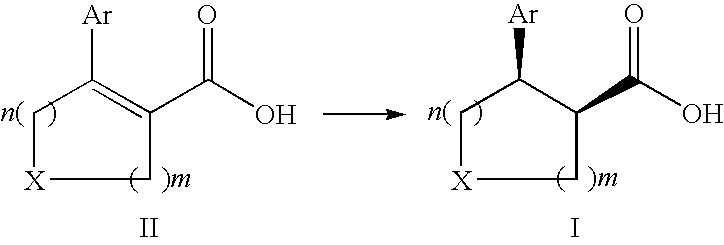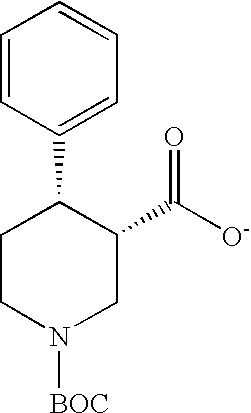Process for the preparation of enantiomerically enriched cyclic beta-aryl or heteroaryl carbocyclic acids
a technology of which is applied in the field of process for the preparation of enantiomerically enriched cyclic betaaryl or heteroaryl carbocyclic acid, can solve the problems of loss of material and general difficulty in synthesizing such compounds, and achieves high diastereo-
- Summary
- Abstract
- Description
- Claims
- Application Information
AI Technical Summary
Benefits of technology
Problems solved by technology
Method used
Image
Examples
example 2
OF I
(−)-4-(1H-Indol-3-yl)-piperidine-1,3-dicarboxylic acid-1-tert-butyl ester and (+)-4-(1H-Indol-3-yl)-piperidine-1,3-dicarboxylic acid-1-tert-butyl ester
[0211]
[0212]In a glove box (O2 content≦2 ppm) a 185 ml autoclave equipped with a mechanical stirrer was charged with 1.00 g (2.92 mmol) of 4-(1H-indol-3-yl)-5,6-dihydro-2H-pyridine-1,3-dicarboxylic acid-1-tert-butyl ester, 8.88 mg (0.0117 mmol) of [Ru(OAc)2((R)-2-furyl)-MeOBIPHEP], 295 mg (2.92 mmol, 1.0 eq.) of triethylamine and 20 ml of methanol. The asymmetric hydrogenation was run for 42 h at 80° C. under 40 bar of hydrogen. After cooling to room temperature the pressure was released from the autoclave, the methanol solution was diluted with 200 ml of tert-butyl methyl ether and extracted with two 100 ml portions of a 1 M aqueous sodium hydroxide solution. The aqueous layer was poured on ice, acidified with ice-cold 2 M aqueous hydrochloric acid solution to pH 1 and extracted with three 200-ml portions of ethyl acetate. The co...
example 3
OF I
(−)-4-o-Tolyl-piperidine-1,3-dicarboxylic acid 1-tert-butyl ester and (+)-4-o-Tolyl-piperidine-1,3-dicarboxylic acid 1-tert-butyl ester
[0216]
[0217]In a glove box (O2 content≦2 ppm) a 35 ml autodave equipped with a 15 ml glass insert and a magnetic stirring bar was charged with 300 mg (0.945 mmol) of 4-o-tolyl-5,6-dihydro-2H-pyridine-1,3-dicarboxylic acid 1-tert-butyl ester, 7.2 mg (0.0094 mmol) of [Ru(OAc)2((R)-(2-furyl)-MeOBIPHEP], 95.9 mg (0.945 mmol, 1.0 eq.) of triethylamine and 6 ml of methanol. The asymmetric hydrogenation was run for 42 h at 80° C. under 40 bar of hydrogen. After cooling to room temperature the pressure was released from the autoclave, the methanol solution was diluted with 100 ml of tert-butyl methyl ether and extracted with two 100-ml portions of a 1 M aqueous sodium hydroxide solution. The aqueous layer was poured on ice, acidified with ice-cold 2 M aqueous hydrochloric acid solution to pH 1 and extracted with three 100-ml portions of ethyl acetate. Th...
example 4
OF I
(+)-4-(3-Methoxy-phenyl)-piperidine-1,3-dicarboxylic acid-1-tert-butyl ester
[0222]
[0223]In a glove box (O2 content≦2 ppm) a 6 ml autoclave equipped with a glass insert and a magnetic stirring bar was charged with 50 mg (0.15 mmol) of 4-(3-methoxy-phenyl)-5,6-dihydro-2H-pyridine-1,3-dicarboxylic acid-1-tert-butyl ester, 7.7 mg (0.0069 mmol) of [Ru(OAc)2((S)-6-MeO-2-naphthyl)-MeOBIPHEP], 17.2 mg (0.172 mmol, 1.15 eq.) of triethylamine and 1 ml of methanol to give an orange suspension. The asymmetric hydrogenation was run for 66 h at 80° C. under 40 bar of hydrogen. After cooling to room temperature the pressure was released from the autoclave, the methanol solution was diluted with 30 ml of tert-butyl methyl ether and extracted with two 30-ml portions of a 1 M aqueous sodium hydroxide solution. The aqueous layer was poured on ice, acidified with ice-cold 2 M aqueous hydrochloric acid solution to pH 1 and extracted with two 50-ml portions of ethyl acetate. The combined organic laye...
PUM
| Property | Measurement | Unit |
|---|---|---|
| pressure | aaaaa | aaaaa |
| pressure | aaaaa | aaaaa |
| temperature | aaaaa | aaaaa |
Abstract
Description
Claims
Application Information
 Login to View More
Login to View More - R&D
- Intellectual Property
- Life Sciences
- Materials
- Tech Scout
- Unparalleled Data Quality
- Higher Quality Content
- 60% Fewer Hallucinations
Browse by: Latest US Patents, China's latest patents, Technical Efficacy Thesaurus, Application Domain, Technology Topic, Popular Technical Reports.
© 2025 PatSnap. All rights reserved.Legal|Privacy policy|Modern Slavery Act Transparency Statement|Sitemap|About US| Contact US: help@patsnap.com



